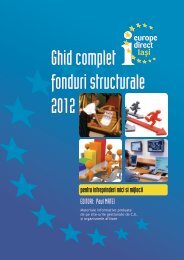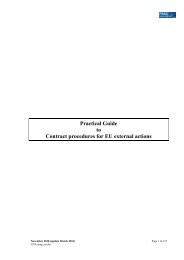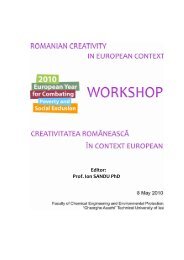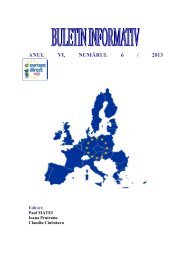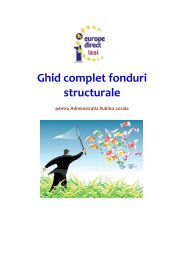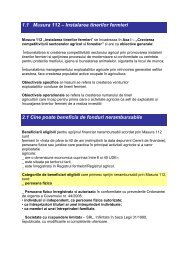2011 - Europe Direct Iasi
2011 - Europe Direct Iasi
2011 - Europe Direct Iasi
You also want an ePaper? Increase the reach of your titles
YUMPU automatically turns print PDFs into web optimized ePapers that Google loves.
EUROINVENT <strong>2011</strong><br />
determines the limit values of processing and usage temperature<br />
of the composite, being at the same time the component that<br />
confers material’s tenacity. The textile composites are used in<br />
cars construction, packaging industry or as building materials.<br />
Nowadays, these materials are used for furniture and for interior<br />
design accessories and ambient art. In order to obtain composites<br />
for ambient art with corresponding biodegradability, there were<br />
used natural fibers and fabrics, linear poly(acryl amide) and an<br />
polyhydroxy derivative of acetone.By modifying the ratio of the<br />
three components (reinforcing material/ matrix/ coupling agent),<br />
there were obtained multilayer composites with controlled<br />
structural, mechanical and biodegradable characteristics.<br />
R.4.<br />
Title Dyeing Wool Fibers with Premetallised Acid Dyes<br />
Authors Chirilă Laura, Butnaru Romen<br />
”Gheorghe Asachi” Technical University of <strong>Iasi</strong>, Faculty of<br />
Institution<br />
Textile, Leather and Industrial Management<br />
Dyeing wool fibers was achieved with new synthesized<br />
premetallised dyes wich are derived from new acid dyes. The<br />
synthesis procedure of the new premetallised is relatively simple<br />
and, in addition, not involve many operations.<br />
As ligands the acid dyes are part of the class of complexed acid<br />
dyes, orto-hidroxi azo compounds type, with sulphonic<br />
solubilising groups. The complexing reagents were used in the<br />
form of transition metals salts, such as : FeCl3, CuCl2, NiCl2 and<br />
respectively ZnCl2. the resulted premetalised dyes were<br />
characterized using the following investigation methods:<br />
elemental chemical analysis, IR-spectrometry, SEM, thermal<br />
analysis.<br />
Description<br />
The synthesized premetallised dyes were tested for the wool<br />
fibers following an experimental protocol, exhibiting a good<br />
affinity. Also the tinctorial strenghts to light and wet treatments,<br />
intensity of colour were tested in order to carry out the dyeing<br />
performances. In all cases the tinctorial strenghts values are<br />
improved comparing with the uncomplexed acid dyes. The<br />
colour of each premetalised dyed sample is changing according<br />
with the used salt. In order to investigate the mechanical<br />
behavior of the dyed samples obtained at two pH values, the<br />
tensile strenghts were evaluated. TEM and XPS were used in<br />
order to evaluate the metal distribution over/into the fiber. The<br />
dyeing influention over the surface integrity of the wool fiber<br />
was investigated using SEM.<br />
Innovative Researches<br />
141



